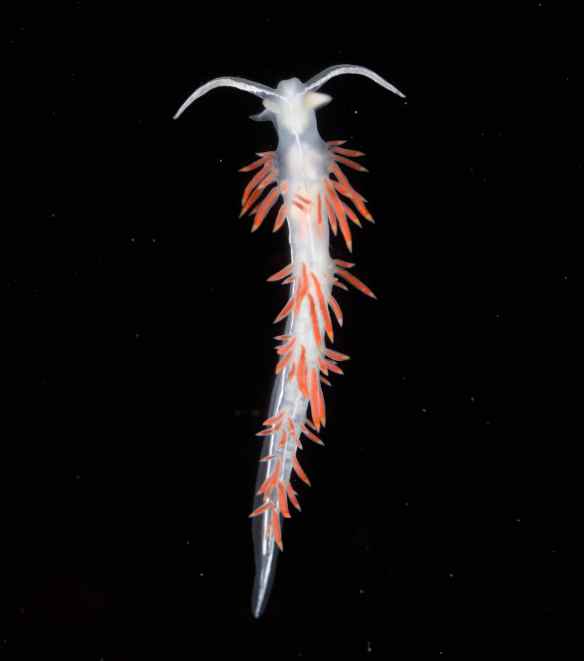Nudibranchs, or sea slugs, are descended from animals with protective shells like those of modern snails. Nudibranchs have lost that shell, leaving them potentially vulnerable: squishy morsels in an ocean full of hungry things. But nudibranchs have some tricks to avoid becoming someone else’s meal: they use their own food to protect themselves.
One trick is to steal the defenses of your prey. Many nudibranchs eat stinging animals like hydroids and anemones. These animals use specialized stinging cells to catch their own prey and to defend themselves.

Hydroids. The stinging cells are on the ends of the long tentacles, waiting to catch prey.
Photo by M. LaBarbera
When the nudibranch eats the stinging animal, its digestive system separates out the stinging cells without triggering them, then stores them in tentacles on its back (called cerata). Anything that attacks the nudibranch then gets stung by those stolen stinging cells.

Hermissenda crassicornis. The lines in the middle of the cerata are part of the digestive system, and the stinging cells are stored at the tips of the cerata.
Photo by M. LaBarbera
Other nudibranchs eat toxic sponges and keep the toxins in their body, rendering themselves toxic. Their bright colors mean, “Don’t bother trying to eat me, I taste terrible.”

Doris montereyensis. This nudibranch will be cryptic on the bumpy yellow sponge it likes to eat, but bright and obvious elsewhere.
Photo by M. LaBarbera

Hypselodoris edenticulata (with a different, tiny nudibranch in the top right).
Photo by M. LaBarbera

Do not eat me. I may be purple, but I am not grape flavored.
Hypselodoris edenticulata.
Photo by M. LaBarbera
But not all nudibranchs are so well-armed. Some simply rely on camouflage: if no one can see you, it will be harder for them to eat you. Tritonia wellsi feeds on gorgonians, a type of soft coral. Each gorgonian is a colony of individuals, with a hard, flexible skeleton inhabited by many polyps, which look like tiny anemones. The body of Tritonia wellsi also looks like tiny anemones: the nudibranch seems to be imitating the appearance of the gorgonian in its body shape, with imitation-polyps covering its back.
Just one problem: the color doesn’t match. This nudibranch’s favorite gorgonian comes in red and yellow, but the nudibranch isn’t either of those colors. These guys aren’t well understood, so I don’t have an answer to that puzzle.
Still, even if they are the wrong color, you have to admit that the faux polyps look pretty good.
Doridella steinbergi eats bryozoans. Like gorgonians, bryozoans aren’t toxic and don’t sting, so there are no defenses to steal. Doridella steinbergi has patterns on its back that mimic the grid-like appearance of the bryozoan colony, concealing it as it feeds.
And it has even gotten the colors right.
















Reblogged this on In Season and commented:
This is one of those, “too cool for words” natural phenomenons. Sea slugs (nudibranchs) are cute and lovable and their “stealing stingers” to protect themselves is a tough girl move. Read all about it in this reblogged post from the blog, Tough Little Birds.
Evolution sure comes up with some interesting solutions to life’s little problems! And the colours and shapes are so pretty. :)
Fascinating facts, Donna. Thank you for sharing.
Fascinating indeed. Though I’m not sure about this whole idea of food being a weapon – for me it’s a comfort!
It’s probably a comfort for the nudibranchs too – what could be more comforting than “That was delicious, AND now if anyone tries to eat me they’ll get a mouthful of stings!”?
Pingback: Rare sea slug, crustacean discoveries in the Netherlands | Dear Kitty. Some blog
Hey! I just wanted to let you know that the nudibranch labeled “Hermissenda crassicornis” is actually a “Janolus fuscus” :) Happy hunting!